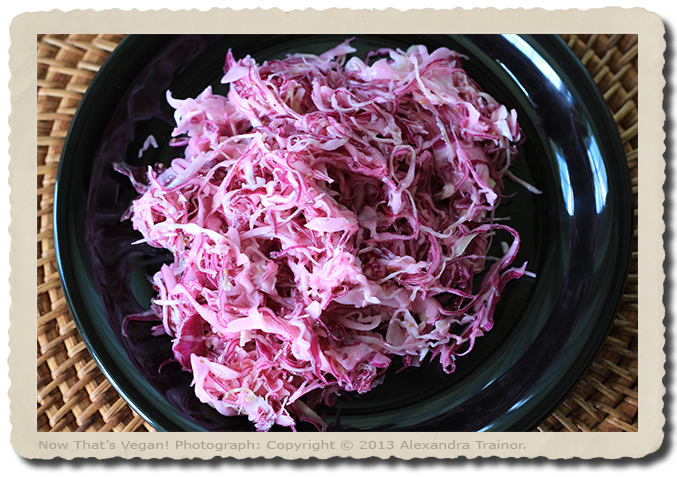 This sauerkraut can be made with either green cabbage or purple cabbage (also known as red cabbage), or a combination of the two. It’s simple to make, because it uses very few ingredients and doesn’t require cooking. Though, plan ahead because it may take 3 to 5 days to ferment and become ready to eat.
This sauerkraut can be made with either green cabbage or purple cabbage (also known as red cabbage), or a combination of the two. It’s simple to make, because it uses very few ingredients and doesn’t require cooking. Though, plan ahead because it may take 3 to 5 days to ferment and become ready to eat.
Ingredients:
- 1 small head green or purple cabbage, or 1/2 of each.
- 2 tablespoons ground pink Himalayan salt
- 1 tablespoon caraway seeds (optional)
Directions:
- Sterilize* a 16 oz mason jar that you’ll be using, as well as any equipment and utensils that will come in contact with the ingredients.
- Wash your hands well, and also the cabbage, then remove from the cabbage one or two of the outer leaves and set them aside.
- On a sterilized Totally Bamboo cutting board or other cutting board, thinly slice the cabbage with your knife.
- Place sliced cabbage in the large bowl. Mix in the salt, and also the caraway seeds if using them. Let sit for 1 hour.
- With clean hands, spend 3 or 4 minutes ‘massaging’ the cabbage and pressing it down into the bowl to release as much of the liquid brine as possible.
- Transfer the cabbage and brine to the glass jar. Carefully press the cabbage down into the jar so that it is tightly packed. Place on top of the shredded cabbage two or three pieces of the reserved cabbage leaves, so that the shredded cabbage is covered by the leaves. The brine should rise above this, leaving 2 inches of airspace at the top. Place a shot glass on the leaves to weigh them down. This prevents the cabbage from floating to the top and exposure to air. Secure with a tight lid.
- In three to five days check to see if the cabbage has fermented. The time it takes to ferment depends on the temperature and humidity in the room. A small amount of gray mold may form along the top which is normal, but should be removed before eating. Discard the large leaves and serve as a side dish or add it to salads. Stores refrigerated in a jar with a tightly sealed lid for a couple of weeks.
Yield:
Makes about 2 cups
* There are many ways to sterilize jars and kitchen tools. The Bottle Store has an article that shares How to Sterilize Glass Bottles and Jars at Home. You can also use stainless steel tools that are first boiled for 10 minutes then placed on a clean dish cloth to air-dry. Also, ask the manufacturer to recommend the best way to sterilize other items and equipment, if using, such as your cutting board, blender container, or food processor bowl.


Leave a Comment